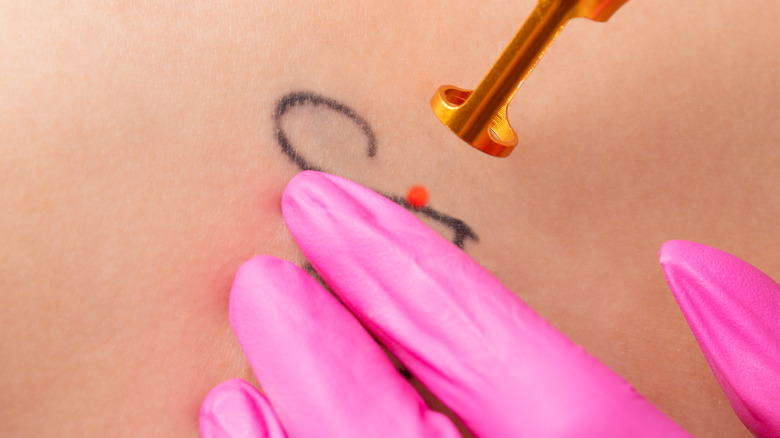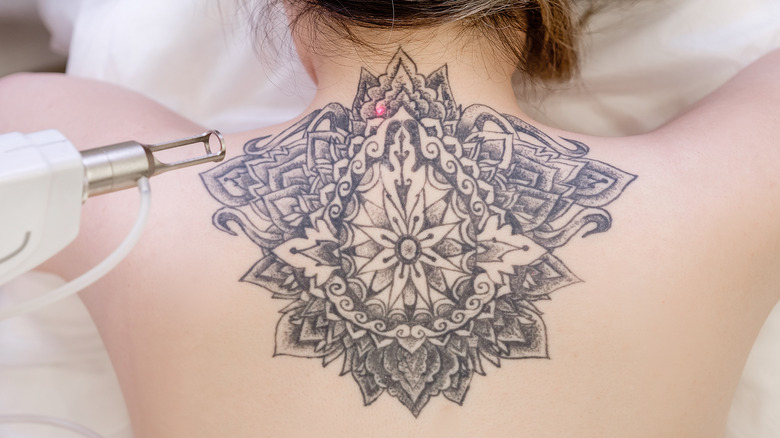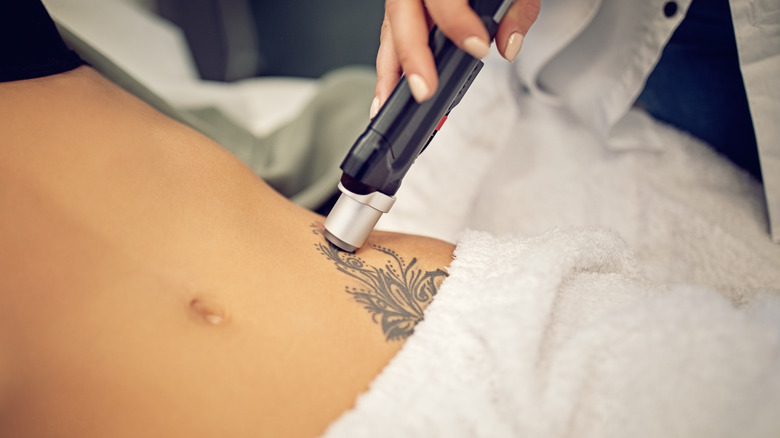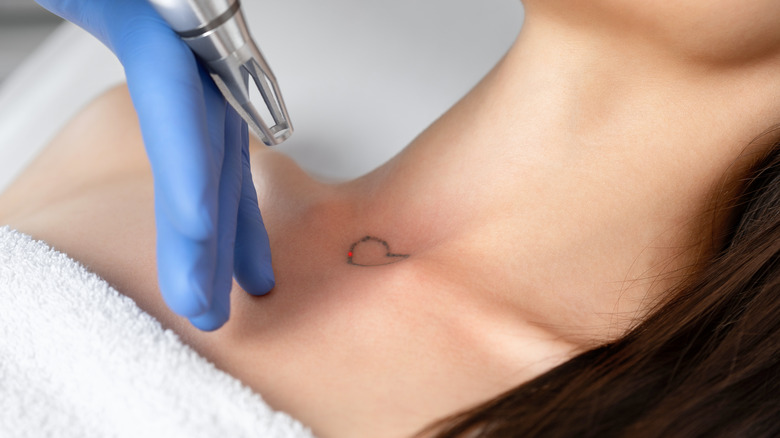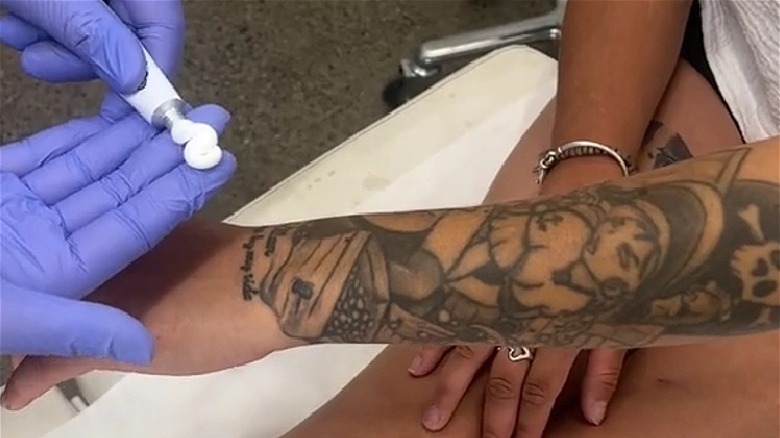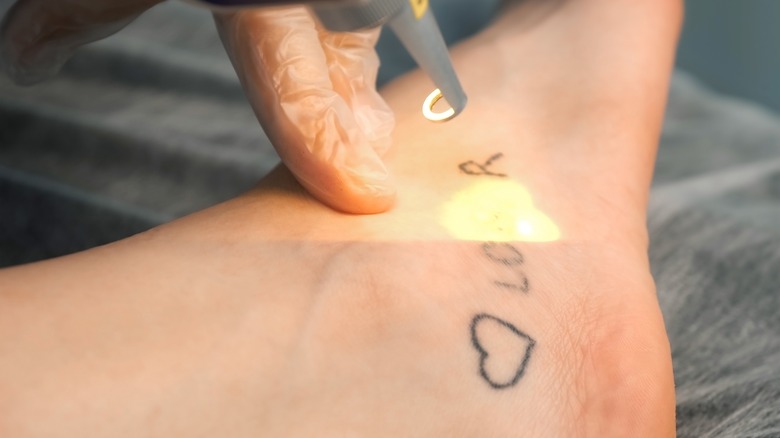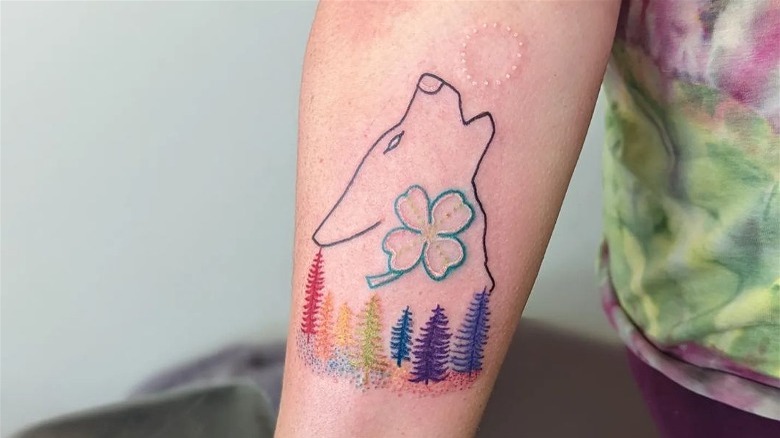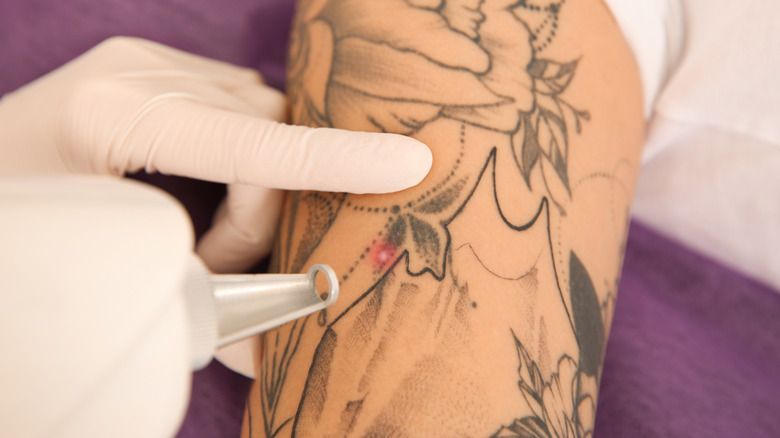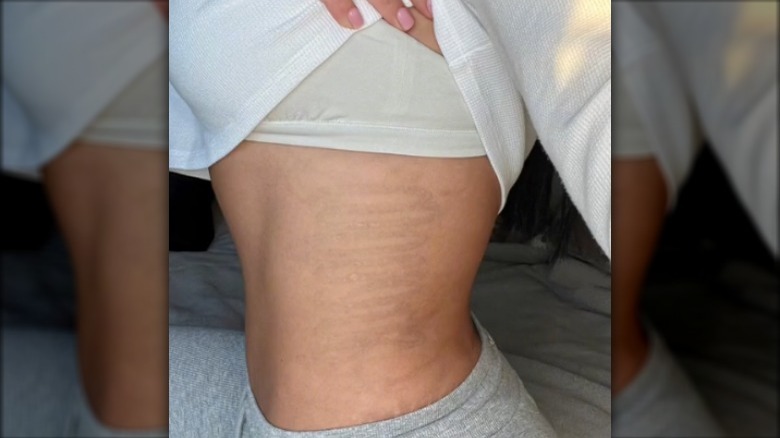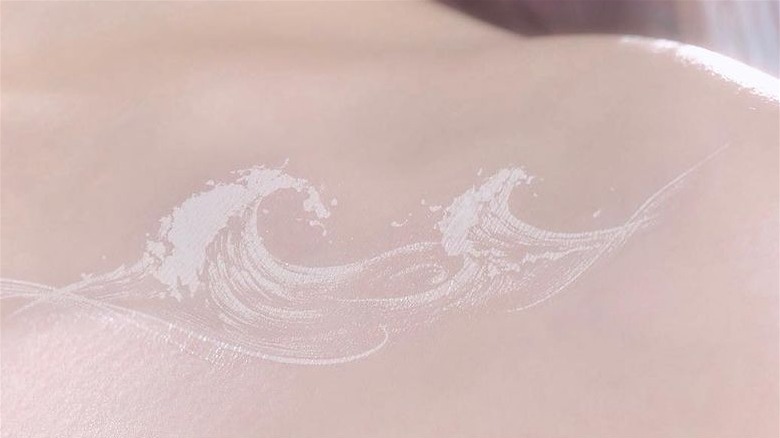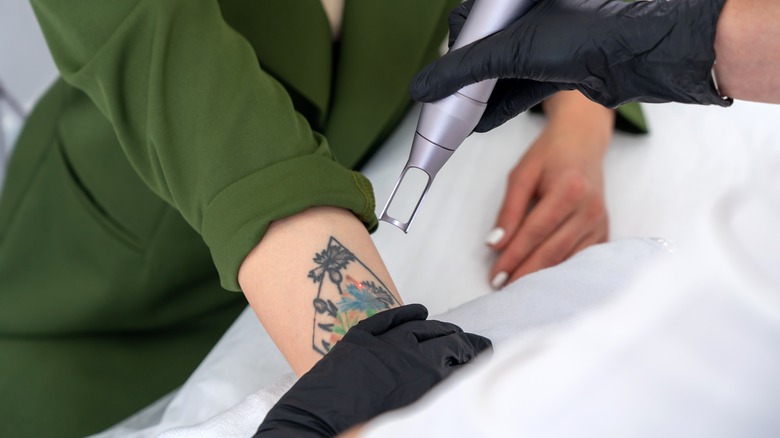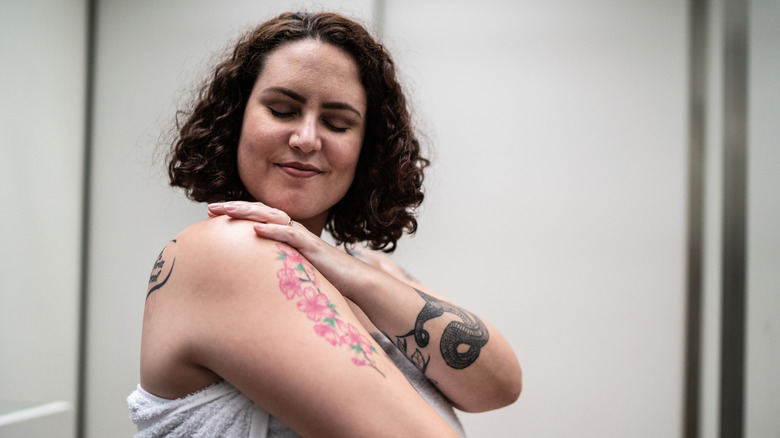We're Answering All Of Your Biggest Tattoo Removal Questions (Um, Yeah, It Hurts)
Tattoos are just as popular as ever. In fact, they may even be more popular than ever. According to Gitnux, in 2023, as many as 30% of people in the U.S. have at least one tattoo somewhere on their body. But with an uptake in ink also comes an uptake in those who regret said ink, as up to 8% of those people felt some remorse about going under the needle. That means the tattoo removal market is totally booming across the world right now, with Gitnux reporting it brought in a staggering $4.34 billion in 2021. And it's only expected to get bigger.
There are a number of different reasons why someone may want to get ink removed, from wanting to rid themselves of memories of a toxic ex or former friend (don't say we didn't warn you about matching tattoos!) to simply changing their minds. But if that sounds like you, and you're ready to wave sayonara to something permanent on your body, you probably have a few questions about the whole thing. And that's good! Before undergoing any kind of procedure on your body, you should always do your research thoroughly, because tattoo removal isn't all that easy. Never fear though, because we've got all the details on everything you need to know about getting rid of your ink, from the different methods, to the cost, to the pain involved (sorry to say, it's probably gonna be some).
What are the best methods of tattoo removal?
Lasering a tattoo off is the most popular method of getting that unwanted ink off your body. It's the most widely available, and also one of the most effective and safest methods for all shapes and sizes of ink, which is why so many people opt for it. But it's not the only way you can remove those unwanted memories.
Dermabrasion is another way you can get a tattoo taken off your skin, and it involves using a medical-grade grinding tool on the ink to essentially sand down the skin. "This allows the tattoo ink to leach out of the skin," Dr. O'Connell, board-certified aesthetic medicine and medical director and president of Laguna Beach Aesthetics, explained to Allure. Dermabrasion isn't a viable option for bigger tattoos though, nor is it recommended for ink with a lot of colors or shading work.
For some people, there's also the option of having a tattoo literally cut off the skin by a professional surgeon. "Surgical removal is an effective alternative for smaller tattoos. If you have a small tattoo and just want a 'one and done' treatment, you [may] be a good candidate for surgical removal," Dr. O'Connell shared.
What can I expect from my first laser tattoo removal session?
For your very first laser tattoo removal session, you'll want to shave down the area before the treatment begins, according to the NHS. When you arrive, you'll be taken to a sterilized area and asked to expose the area of your tattoo ready for it to be zapped away (you could be asked to sit or lay down depending on where your ink is). You should be given goggles to shield your eyes from the laser, and you'll have a numbing cream applied.
The laser will then start to be pressed against your skin. It works by breaking down the ink in the tattoo, which is then safely absorbed into your bloodstream and discarded by the body. "You want a very strong, intense energy to essentially microscopically break up and damage those pigment cells," dermatologist Roberta Del Campo explained of the process to Teen Vogue. "Each cell has [a color], so it's actually exploding them underneath the skin. It makes them rupture under the skin, the pigment then comes to the surface over the next week." Board-certified dermatologist Dr. Jeffrey Fromowitz also explained to Allure that, during your first session, the tattoo will briefly turn white. After the session is over, the removal expert may apply a cooling gel to counteract the heat of the procedure, and you may find a dressing is applied depending on how well your skin reacted to the treatment.
How much does tattoo removal cost?
Just like when getting a tattoo, how much it actually costs to get it removed will hinge on a number of factors. One of the biggest determinants will be how big the tattoo is. The bigger your ink, the more lasering it will need, which will mean longer sessions and more returns to the chair. Things like the colors in your tattoo and how detailed it is may also influence the price, and each business will have its own pricing structure, which means costs will fluctuate between different companies.
When getting a quote, you can expect to pay for things like the surgeon's fee, any facility costs as well as the cost of the procedure itself, as well as the potential cost of any anesthesia or medications you may need afterward. On average, the American Society of Plastic Surgeons found that the average cost of having a tattoo lasered off sets people back around $423. As a more general rule of thumb though, Astanza estimates that it could cost around 10 times more to remove a tattoo than it originally cost to have it put onto your skin.
As for dermabrasion, removing a smaller tattoo could cost around $200, but that could stretch into the thousands for bigger designs. Surgical removal prices can vary wildly depending on the facility, so quotes tend to be given on a person-by-person basis.
Does it hurt?
Just like getting the tattoo causes a bit of a sting (to put it lightly), getting it removed isn't a walk in the park either. You're more than likely to feel some discomfort when you get a tattoo removed no matter what method you opt for, but how much pain you'll be in will depend on a few things, including how faded your ink is, where it is, and its size.
Aesthetic doctor Dr. Rekha Tailor opened up about what the lasering process really feels like to Glamour, explaining, "The procedure does come with some degree of pain; the stinging sensation could be compared to the flicking of an elastic band against the skin." One thing you shouldn't be feeling during a laser session though is unbearable pain, because a professional should use some form of numbing treatment. "If it's not used it's extremely painful because it's so hot," Dr. Del Campo told Teen Vogue of why it's so important to make sure your tattoo remover is using the right equipment. "It is the most painful laser on the market because you're just rupturing everything — all that pigment under the skin you're just exploding it — and it's very uncomfortable."
Dermabrasion can also be pretty painful, so it's also usually done under anesthetic, according to the American Society of Plastic Surgeons. Those opting for having a tattoo surgically removed will likely feel the least amount of pain during the procedure, as it involves injecting a numbing agent into the skin before the process begins, per Allure.
How long will it take?
Don't head into your first tattoo removal session and think you're going to come away a totally blank slate, because it's more than likely going to take a good few sessions to totally remove that ink from your skin if you try laser or dermabrasion. Exactly how long you need will depend on a few different factors, with aesthetic doctor at Health & Aesthetics Clinic, Dr. Rekha Tailor, telling Glamour, "The age of the tattoo, skin tone, size of the tattoo, ink depth, intricacy of design and type of pigment used are all factors that will contribute to your treatment timeline."
A rough estimate for those opting for laser treatment could be around six to 20 sessions every eight to 10 weeks. How many times you have to return to the laser will also depend on how long your sessions are. A typical tattoo removal session will be dependent on exactly how big the design is, but it could take anywhere between five and 30 minutes each time. In terms of the overall timeline, you could be looking at anywhere between 12 and 24 weeks to have your ink fully dissolved by a laser.
If you opt for dermabrasion, that could take around three sessions, per Allure, but just like a laser, that timeframe will be dependent on the size and depth of the ink. Surgical removal is usually the quickest option of the three, as your tattoo will be completely gone after one session.
Is it possible to speed up (or slow down) the process?
It turns out there is a way you can try to improve the results of the tattoo removal process, and speed up the overall timeline. For laser treatments, massaging the skin over the tattoo on a daily basis, once the initial scabbing has gone down, to help blood flow is one great way to help the process move along quicker, according to Radiant Living. It's also recommended that you drink a lot of water to keep yourself feeling healthy and help flush out any toxins, get regular exercise (only after 48 hours post-treatment, though), and spread out your laser sessions (around every 10 weeks is recommended) to allow the skin more time to heal properly.
There are some factors that could delay the healing process for laser treatments as well though, including being a smoker. People who regularly smoke tobacco will potentially need a little more time to heal after a session, and will need to be extra careful when it comes to making sure enough time has passed in between sessions. According to Vanish Clinic, the chemicals in cigarettes can affect the immune system and almost work against the tattoo removal process, meaning the ink takes longer to fade.
Are some tattoo ink colors easier to remove than others?
Not all tattoos are created equally, as it turns out that some are easier to remove than others. Tattoo removal expert Lorena Öberg explained to Glamour that certain colors on the skin can be gotten rid of quicker than others when using the laser method. Which shades of ink are among those easier to break down? Black, brown, dark blue or green, while shades of red, orange, yellow or pale blue are thought to take more vigorous effort to get out of the skin.
As for why it takes some colors longer to leave than others? That's because there isn't one singular laser that's able to remove every single tattoo color, according to Cleveland Clinic. Instead, the different dyes that are mixed together to create the many colors available for tattoos have different ways of reacting to the wavelengths of light coming out of the removal laser. That's why if you have something darker, like a black tattoo, it's likely to react better to the removal process than something in a lighter shade such as orange.
Does tattoo removal have any side effects?
Getting a tattoo removed, like anything medical, poses its own risks and can come with some side effects — no matter what method you choose. According to NHS statistics, as many as 3% of people have been known to experience permanent scarring following laser treatment.
Equally, the laser can actually darken or lighten the skin's pigment over and around the tattoo area, which could leave you with discoloration, as described by Cleveland Clinic. "In general, laser tattoo removal is the most common for patients getting scarring and discoloration, because as you can imagine [the laser] is so hot that it can be damaging," Dr. Del Campo explained to Teen Vogue. "All it takes is one blister that doesn't heal and you get [a] scar. I've seen it commonly — unfortunately it's more common than not."
When it comes to dermabrasion, the process leaves you with an open wound that can take around 10 to 14 days to heal, therefore you may be feeling sore for a few weeks and open to the potential of an infection, per the American Society of Plastic Surgeons. With surgical removal technique, just like with most surgeries, it's the most likely to leave a permanent scar. It also comes with all the regular risks of having any kind of surgery, from complications during the procedure to the potential for infection afterward.
How do I take care of my skin after a removal session?
Just like there are important post-tattoo aftercare tips, there are important post-tattoo removal aftercare dos and don'ts too. According to the NHS, some people may find their skin bleeds or scabs over during laser treatment, which is normal, but it's what you do after the session to take care of the side effects that really matters.
You can use things like aloe vera to soothe the area before it scabs, but ensure you leave any scabs alone to avoid infection. Another great way to help your body heal as quickly as possible? Make sure you steer clear of body products that may irritate the area, such as perfumed lotions or shower products, for the first 48 hours, as well as refraining from heavy physical activity for the same period. Immediately after, you may want to put a cold compress on the skin to help with irritation, redness or rashes, and avoid going into the sun or hitting a tanning bed for at least seven days.
When it comes to dermabrasion, you'll likely be given an antibiotic ointment to help with the healing and the area may be bandaged, per the UK Health Center. It's also recommended you keep the treated area out of direct sunlight for six months. For surgical tattoo removal, Dr. O'Connell told Allure, "For the first two weeks, we recommend keeping the treated site clean and avoiding direct sun exposure. An antibiotic ointment will be prescribed to help the site heal and prevent infection."
Can anybody get a tattoo removed?
There are a few people who should stay away from tattoo removal. If you're pregnant, it's advised you wait to start the process, or if you're already undergoing removal, to stop until at least three months after your pregnancy, according to the Andrea Catton Laser Clinic. There's no strong research to confirm undergoing laser tattoo removal will directly harm an unborn child, so the risk is minimal if you have a sitting not knowing you're pregnant, but because of the way the treatment relies on the immune system to break down the ink particles and the risk of infection, it's always better to be on the safe side. The same goes for any unnecessary surgery or damage to the skin caused by surgical removal or dermabrasion.
There are also certain skin tones and tattoo combinations that lasers aren't as effective on. If you have white ink on pale skin or dark ink on Black skin, for example, it can be difficult for the laser to know what's ink and what's your skin. "If it can't differentiate the two, it's not going to work. And then you have to go very low and you're going to get no improvement, or you have to go very high and you can get scarring," Dr. Del Campo told Teen Vogue.
Another thing you may not think of when it comes to your tattoo removal treatments? Not going with a tan, per Cleveland Clinic. The laser could alter the skin's pigmentation, which leaves you more open to permanent discoloration.
Can I get multiple tattoos taken off at once?
It is possible to get more than one tattoo removed at a time, as some tattoo removal companies will remove multiple bouts of ink in the same session, if you're having laser or dermabrasion removal, per Princeton Aesthetics. Just remember, though, that if you're getting several bits of ink taken away you'll need to make sure you're booking in longer sessions each time, so it's always a good idea to tell the person doing the procedure the size and locations of your ink before you get started. That way, you'll have a better understanding of what is and isn't possible in each session. It's also worth remembering that the whole process to being tat-free will probably be a few days longer, if not weeks, depending on how many you want removing.
If you're looking into the surgical removal technique though, because of how invasive the procedure can be and the healing process that follows any kind of surgery, you might want to consider having only one set of ink taken off your body at any given time.
Will I be able to get a new tattoo in the same area?
In most cases, it is possible to have a new tattoo in the same place you had one removed from. Before getting a new tattoo in a place that's undergone the removal process though, we'd always suggest letting your tattoo artist know beforehand so they can look into whether you'd be susceptible to any health risks in doing so. That's because, sometimes, in rare cases, laser tattoo removal can cause scar tissue which could prevent any further ink from settling into the skin properly, according to sk:n clinics.
Tattooing over the site of old ink could also come with some extra care instructions afterward, which is why you should always tell your specialist, and you'll also want to make sure you want until the site of your old tattoo is totally, 100% healed before you try putting anything new there. If you opted for surgical removal, it is possible to tattoo over the scar, but take extra care in making sure the site of the old ink is fully healed, and your tattoo artist is experienced in tattooing over scars to avoid extra pain or the chance of infection. As related by Stories & Ink, for deeper scars, it could take up to a year for it to be completely healed.
